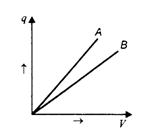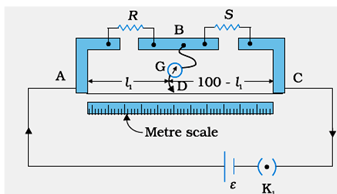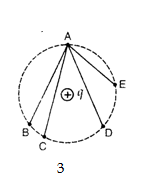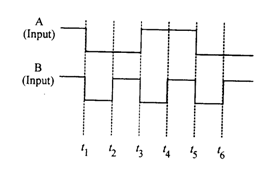Sample Paper of Physics 2014 for class 12, CBSE. Paper No.1
Sample Paper – 2014
Class – XII
Subject – Physics
MM: 70 TIME : 3h
General Instructions
(a) All questions are compulsory.
(b) There are 30 questions in total. Questions 1 to 8 carry one mark each, questions 9 to 18 carry two marks each, questions 19 to 27 carry three marks each and questions 28 to 30 carry five marks each.
(c) There is no overall choice. However, an internal choice has been provided in one question of two marks, one question of three marks and two questions of five marks each. You have to attempt only one of the given choices in such questions.
(d) Use of calculators is not permitted.
(e) You may use the following physical constants wherever necessary :
c = 3 x 108ms-1 ; h = 6.6 x 10-34Js ; e = 1.6 x 10-19 C
μo = 4 π x 10−7T m A−1 ; Boltzmann constant k = 1.38 x 1023 JK-1
Avogadro’s number NA = 6.023 x 1023/mole
Mass of neutron mn = 1.6 x 10-27 kg
- If the number of turns and the length of a solenoid are doubled keeping the area of cross section same, how is the inductance affected? 1
- Draw a labelled diagram of Simple microscope. 1
- A variable frequency a.c. source is connected to a capacitor. Will the displacement current increase or decrease with increase in frequency? 1
- The current sensitivity of a moving coil galvanometer is 5 division/mA and voltage sensitivity is 20 division/volt. Find the resistance of the galvanometer. 1
- The divisions marked on the scale of an ac ammeter are not equally spaced. Why? 1
- The forbidden energy gaps in insulators, semiconductors and conductors are EG1, EG2 and EG3 respectively. Arrange them in ascending order. 1
- What is the relation between power gain, voltage gain and current gain of a transistor amplifier? 1
- Write two important characteristics of nuclear forces. 1
- The given graph shows the variation of charge q versus potential difference ‘V’ for two capacitors C1 and C2. The two capacitors have same plate separation but the plate area of C2 is double than that of C1. Which of the lines in the graph correspond to C1 and C2 and why? 2
- The storage battery of a car has an emf of 12 V. If the internal resistance of the battery is 0.4 Ω, what is the maximum current that can be drawn from the battery? 2
- Name materials, one in each case, which are suitable for
a. a permanent magnet & b. core of an electric transformer,
Justify your answer. 2
- Name the waves that are often referred to as ‘heat waves’. Name the physical quantity that has:
- higher,
- lower
c. same value for these waves, as compared to X-rays. 2
13a. In a metre bridge, the balance point is found to be at 39.5 cm from the end A, when the resistor S is of 12.5 Ω. Determine the resistance of R.
- Determine the balance point of
the bridge above if R and S are
interchanged. 2
- A ray of light passes through a prism in the position of minimum deviation. Trace the path of the reflected ray. What is the inclination of the ray (inside the prism) with the base of the prism. 2
- The ionization energy of hydrogen atom is 13.6 eV. Following the Bohr’s theory, find the energy corresponding a transition between the 3rd and 4th orbit. 2
OR
Calculate the shortest and the longest wavelength emitted in the Balmer Series.
- A 100W sodium lamp radiates energy uniformly in all directions. The lamp is located at the centre of a large sphere that absorbs all the sodium light which is incident on it. The wavelength of the sodium light is 589 nm.
a. What is the energy per photon associated with the sodium light?
b. At what rate are the photons delivered to the sphere? 2
- Consider an optical communication system operating at . Suppose, only 1% of the optical source frequency is the available channel band-width for optical communication. How many channels can be accommodated for transmitting audio-signals requiring a band-width of 8 kHz. 2
- de-Broglie wavelength associated with an electron accelerated through a potential difference V is . What will be its wavelength, when the accelerating potential is increased to 4 V? 2
- Consider a uniform electric field E = 3 × 103 î NC-1.
(a) What is the flux of this field through a square of 10 cm on a side whose plane is parallel to the yz plane?
(b) What is the flux through the same square if the normal to its plane makes a 60° angle with the x-axis? 3
20a. For circuits used for transporting electric power, a low power factor implies large power loss in transmission. Explain.
- A lamp is connected in series with a capacitor. Predict your observations for d.c. and a.c. connections. What happens in each case if the capacitance of the capacitor is reduced? 3
OR
An alternating voltage and the corresponding current are given by
= 110 sin( + /6) and I = 5 sin( – /6) respectively.
Find the impedance and the average power dissipation in it.
21a. A point charge q is placed at O and the same is symmetrically surrounded by four similar charges each at distance R from point O. Find the work done by the Coulomb’s force when charge at O is taken to infinity.
- A +q charge is placed at centre as shown in the fig . Find the work done in taking a charge from A to B, A to C and A to E. 3
- Explain polarization by reflection. State and prove the Brewster’s law of polarisation. 3
- Length of a conductor is increased to three times. What is its effect on
a. drift speed of electrons, - resistance and
c. resistivity
if potential across the conductor is kept constant. 3
- The primary of a transformer has 200 turns and the secondary has 1000 turns. If the power output from the secondary at 1000 V is 9 kW, calculate
a. the primary voltage and
b. the heat loss in the primary coil if the resistance of primary is 0.2 ,
the efficiency of the transformer is 90%. 3
- Two narrow slits are illuminated by a single monochromatic source. One of the slits is now completely covered. What is the name of the pattern now obtained on the screen? Draw intensity pattern obtained in the two cases . Also write two differences between the patterns obtained in the above two cases. 3
- Consider the fission of 238U92 by fast neutrons. In one fission event, no neutrons are emitted and the final end products, are 140Ce58 and 99Ru44 . Calculate Q value
for this fission process. The relevant atomic and particle masses are
m(238U92 ) =238.05079 u, m(140Ce58 ) =139.90543 u
m(99Ru44 ) = 98.90594 u & mn = 1.00867 u 3
27a. Draw the block diagram of a communication system.
- What is meant by ‘detection’ of a modulated carrier wave? Describe briefly the essential steps for detection. 3
28a. State the Ampere’s Circuital Law. Calculate an expression for the magnetic field due a straight conductor. 3
- Calculate the torque on a 100 turn rectangular coil of length 40cm and breadth 20cm, carrying a current of 10A, when placed making an angle of 600 with a magnetic field of 3T. 2
OR
- State the Biot Savart’s Law. Derive an expression for the magnetic field at the centre of a circular current carrying coil. 3
- A long wire is bent into a circular coil of one turn and then into a circular coil of smaller radius having n turns. If the same current passes in both the cases, find the ratio of the magnetic fields produced at the centres in the two cases. 2
29a. Find the position of the image formed by the lens of focal length 10cm, for an object placed 30cm in front. Another lens is placed in contact with this lens to shift the image further away from the lens. What is the nature of the second lens? 2
- Why is the apparent depth of an object placed in a denser medium less than the real depth? For viewing near the normal direction, show that the apparent depth is real depth divided by the refractive index of the medium.
What is normal shift. Write an expression for it. 3
OR
- Two lenses of power +15 D and – 5 D are in contact with each other forming a combinations lens.
i. What is the focal length of this combinations ?
ii. An object of size 3 cm is placed at 30 cm from this combination of lenses.
Calculate the positions and size of the image formed. 3 - How can we determine the focal length and power of a convex lens required to correct a hypermetropic eye? 2
30 a. Discuss the action of a transistor as a switch. 3
b. The given inputs A, B are fed to a 2-input NAND
gate.
Draw the output wave form of the gate. 2
OR
- Discuss the action of a transistor as an
oscillator. 3 - Draw the output wave form at X, using
the given inputs A, B for the logic circuit shown below. Also identify the gate. 2
Paper Submitted By :
Name : Mr Kundan Dogra
Email : kld.69@rediffmail.com
Phone No. : 09419106552


























